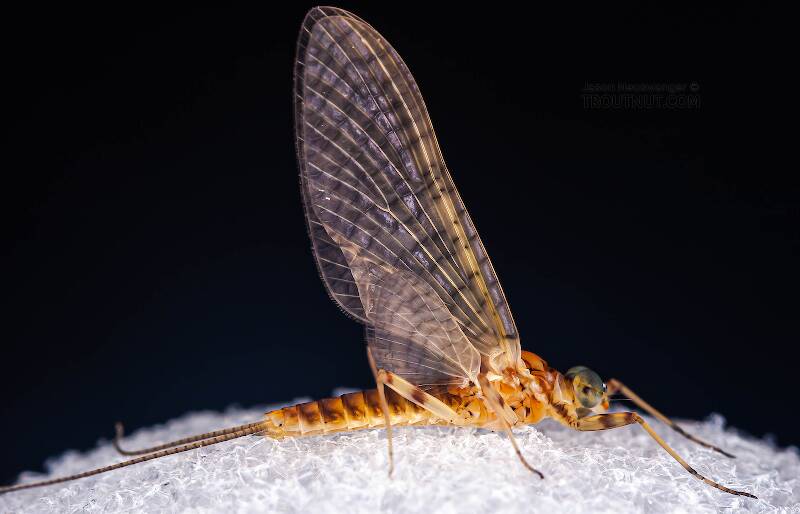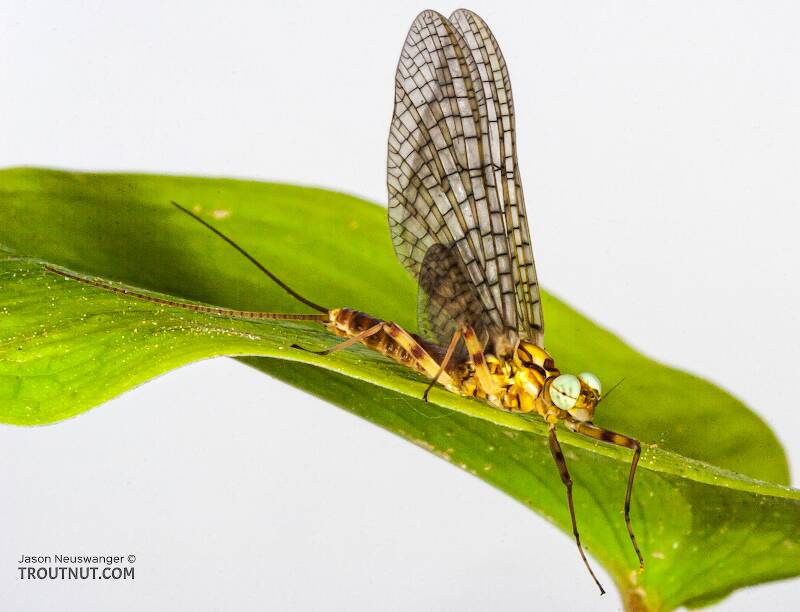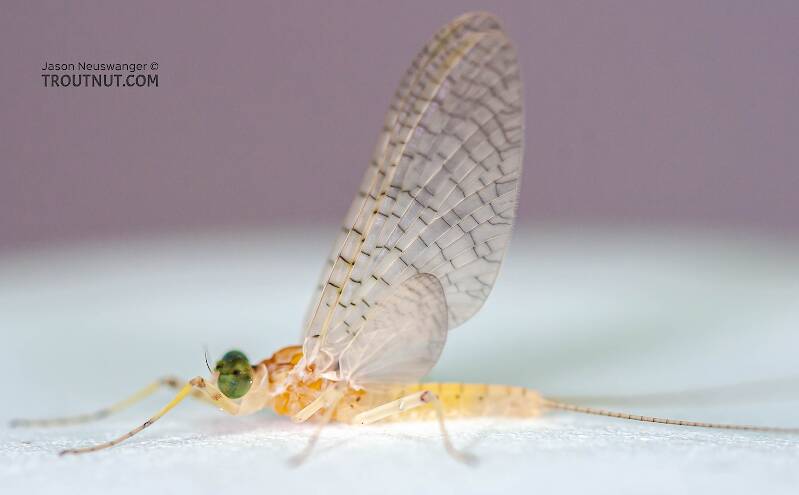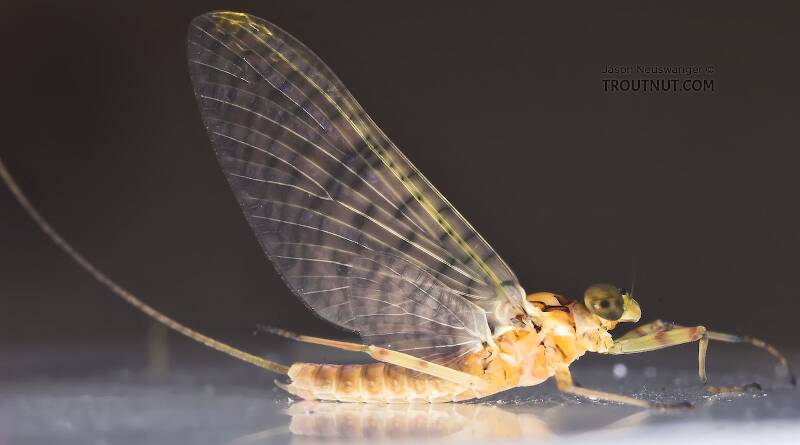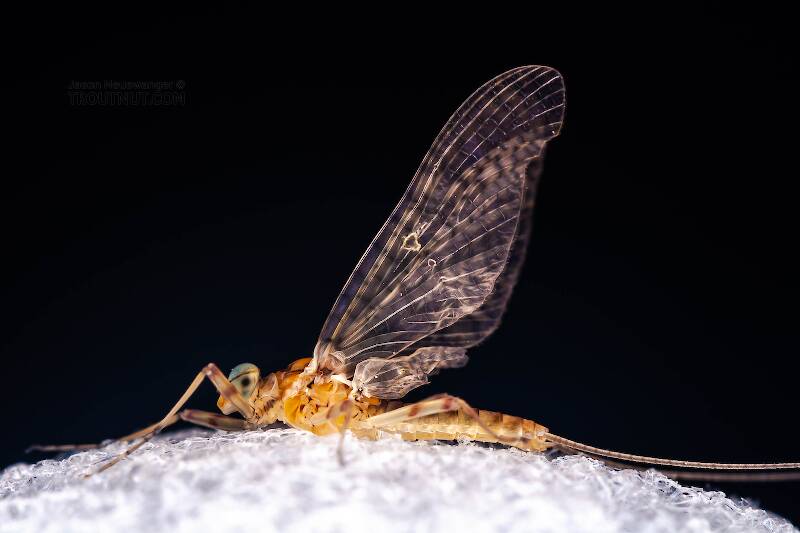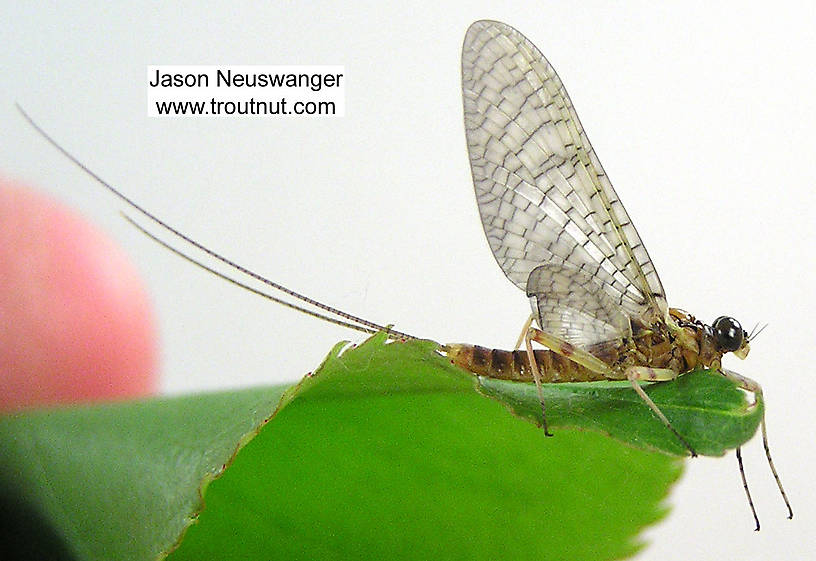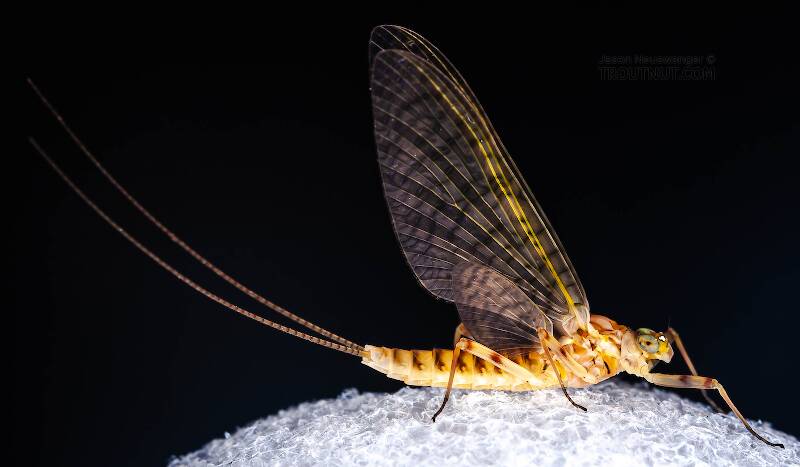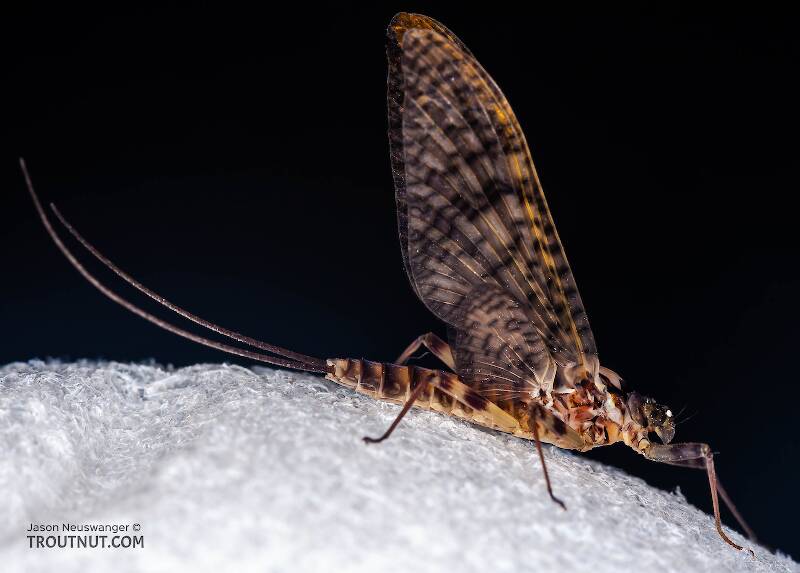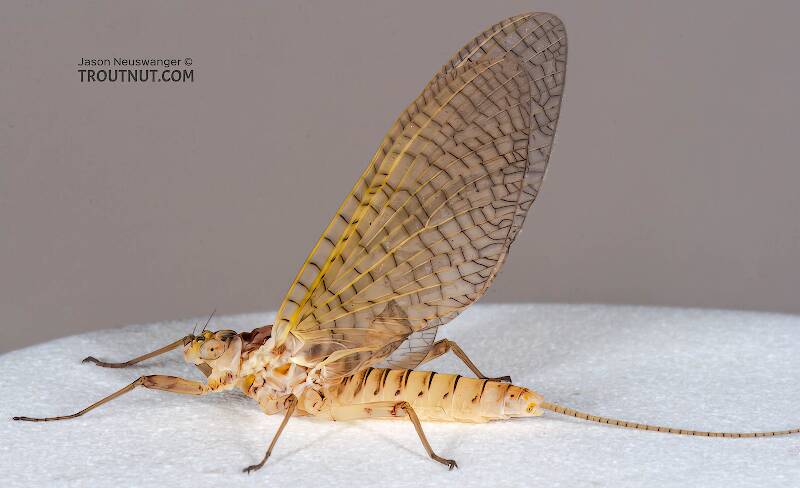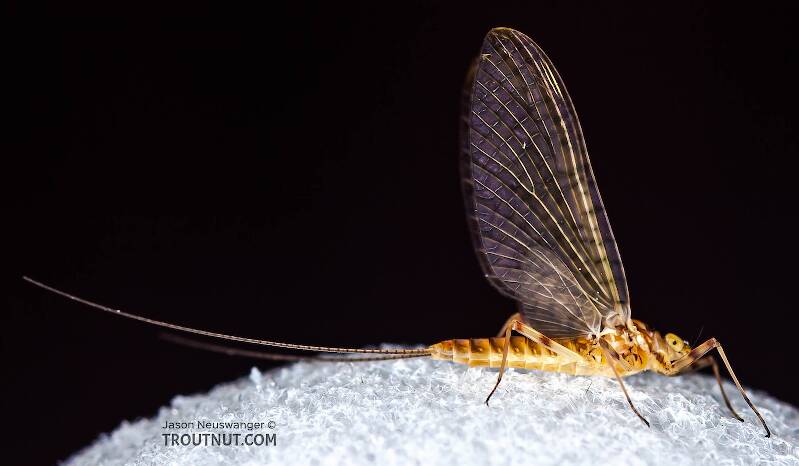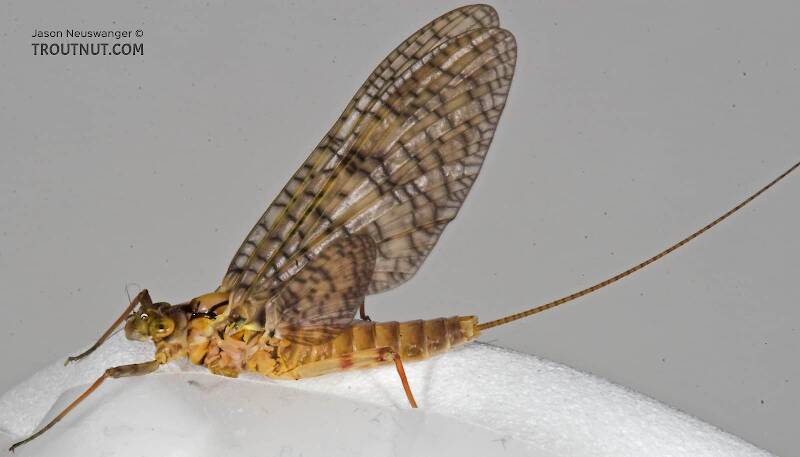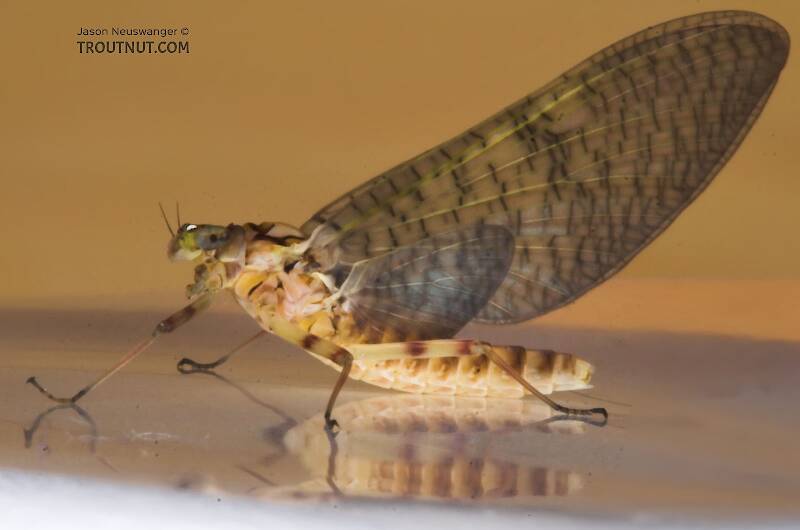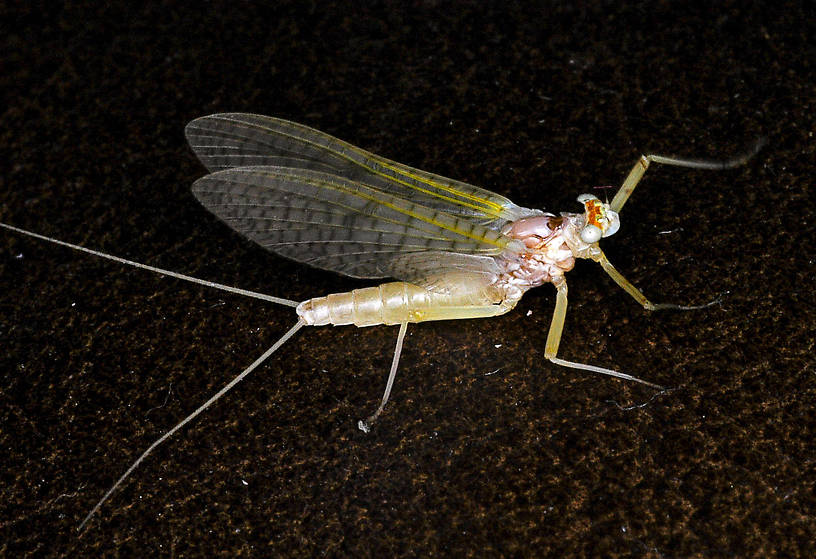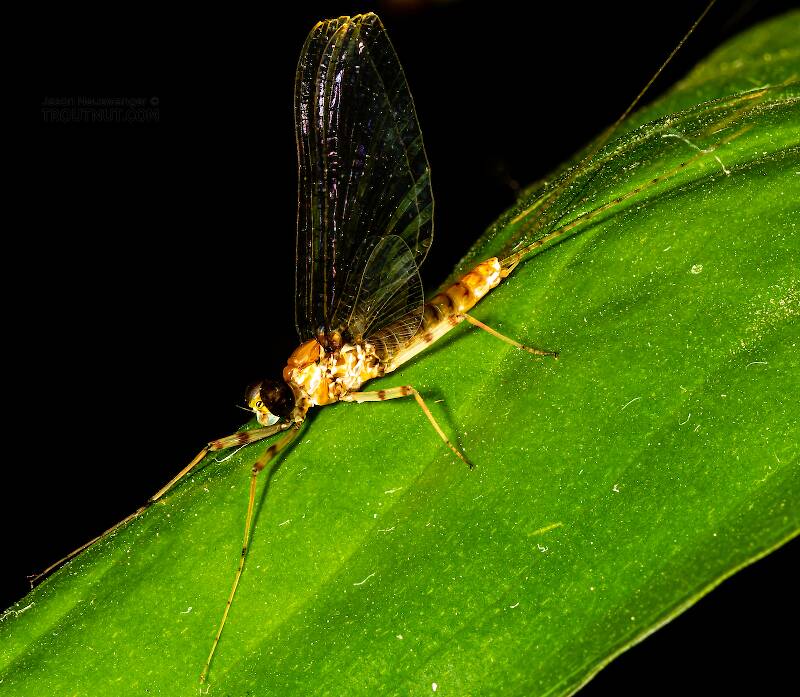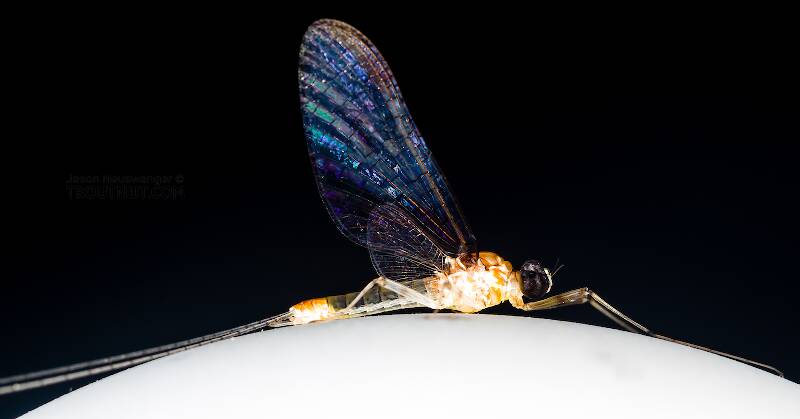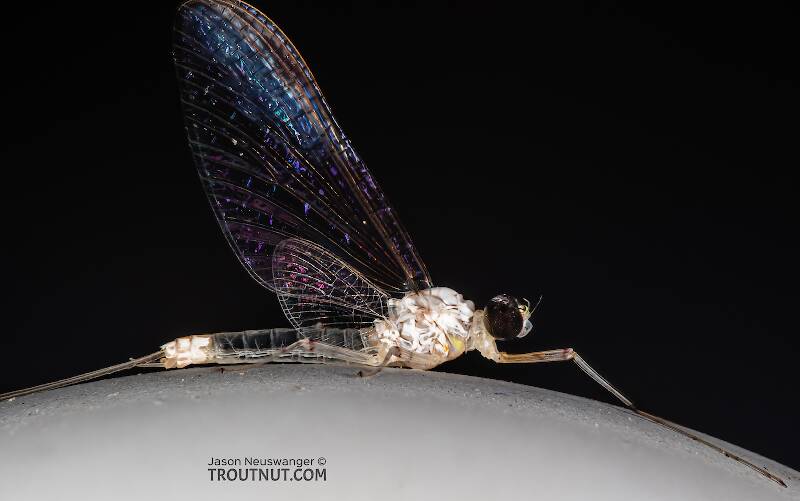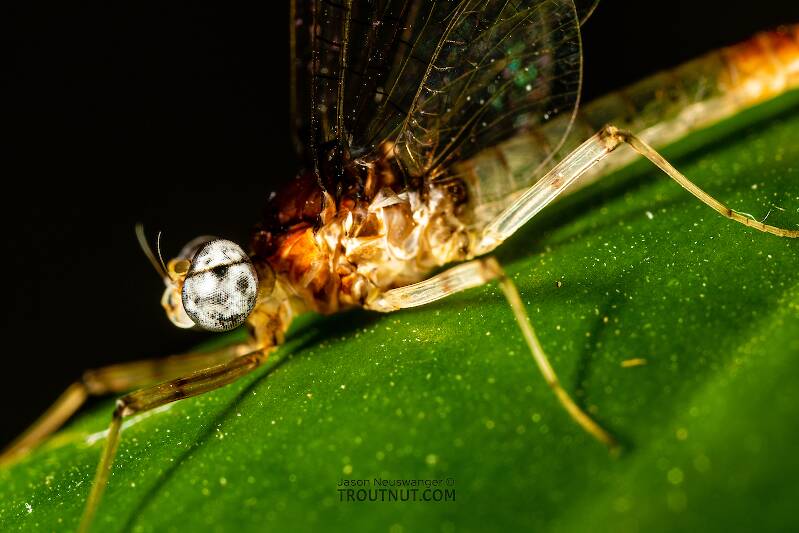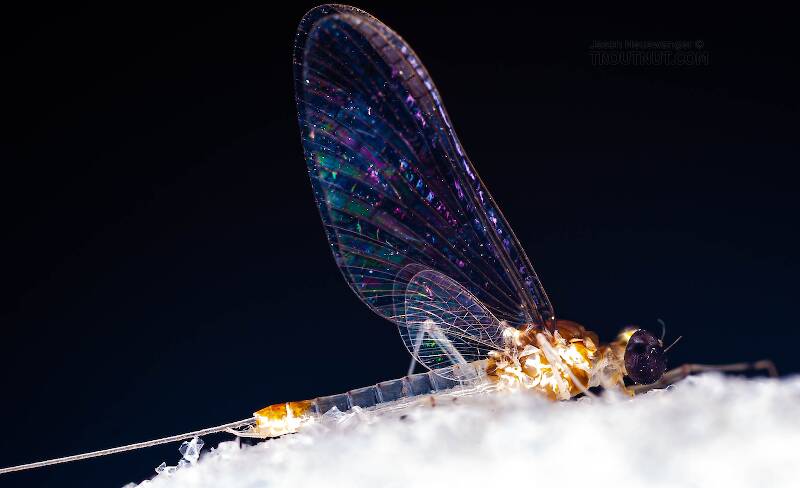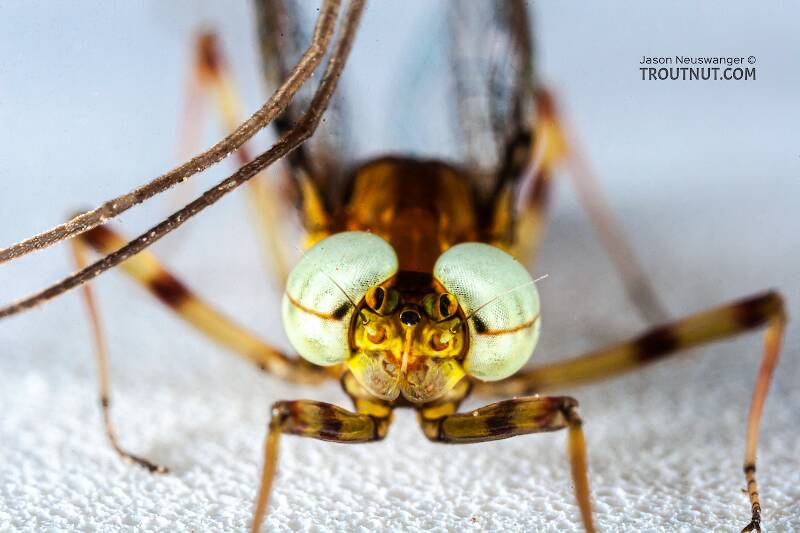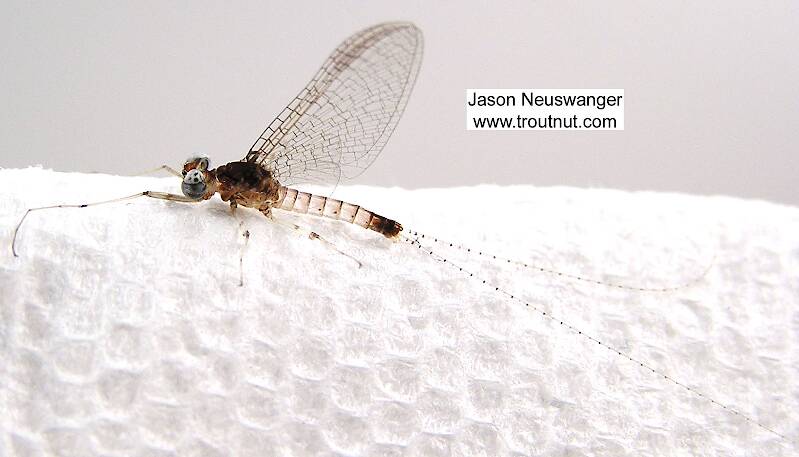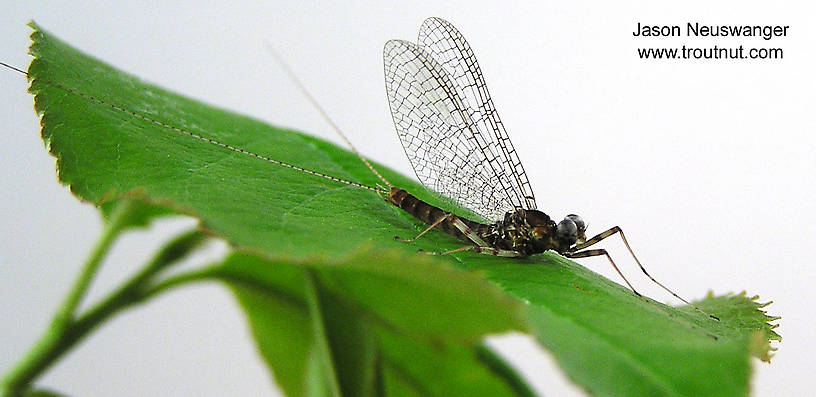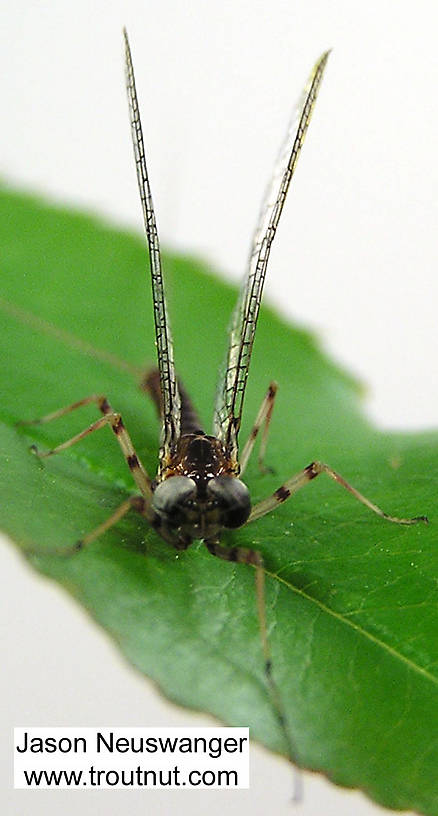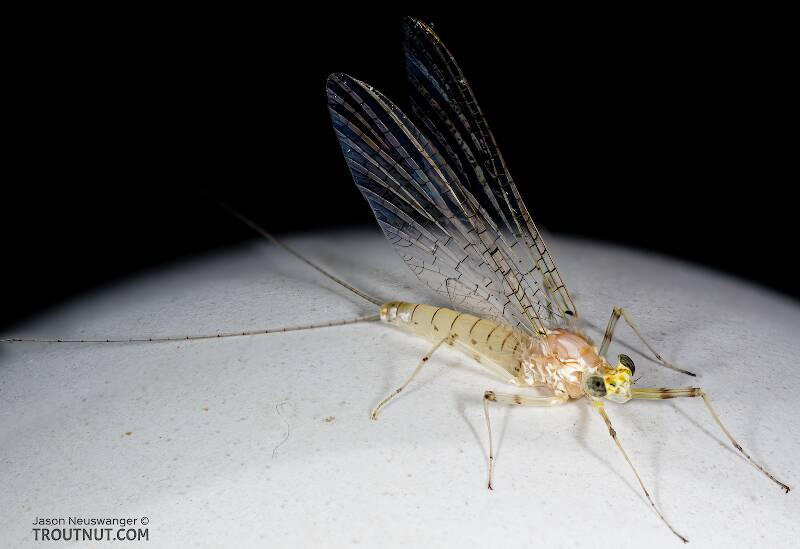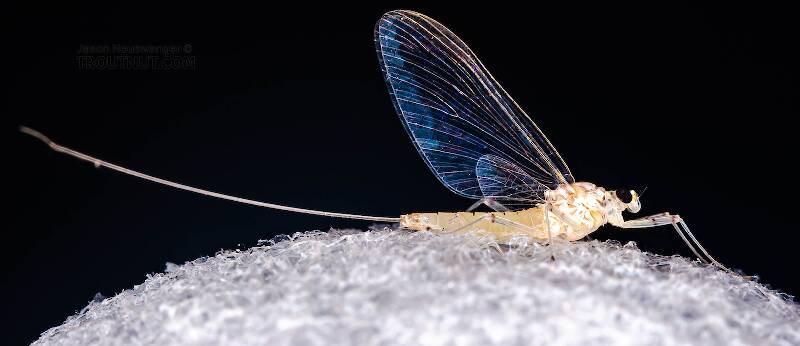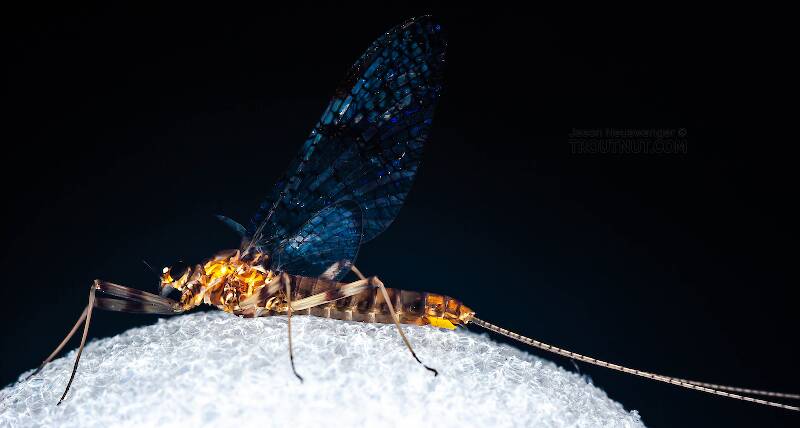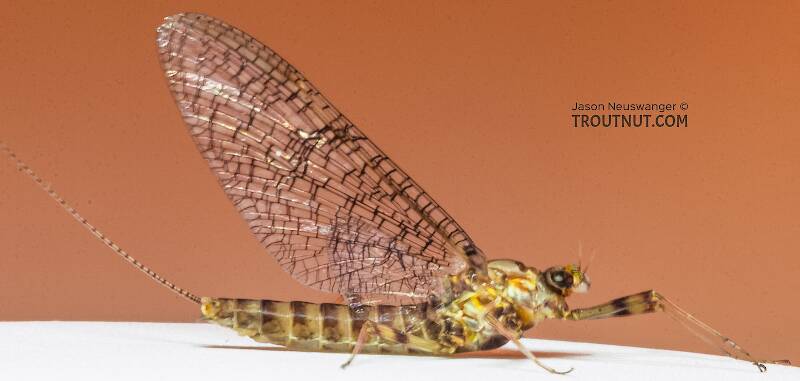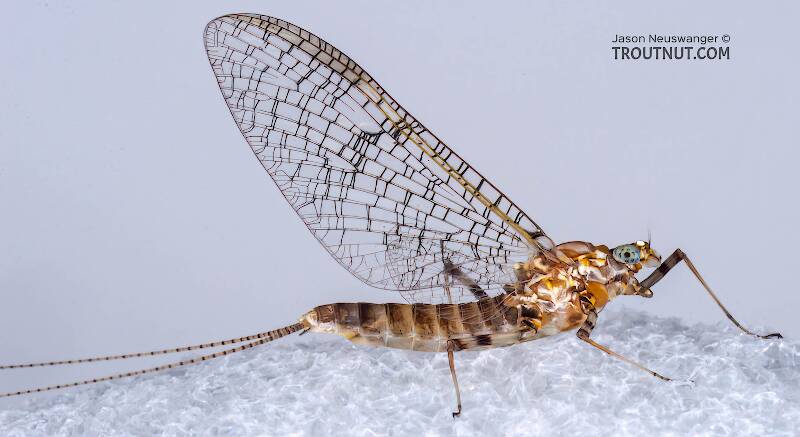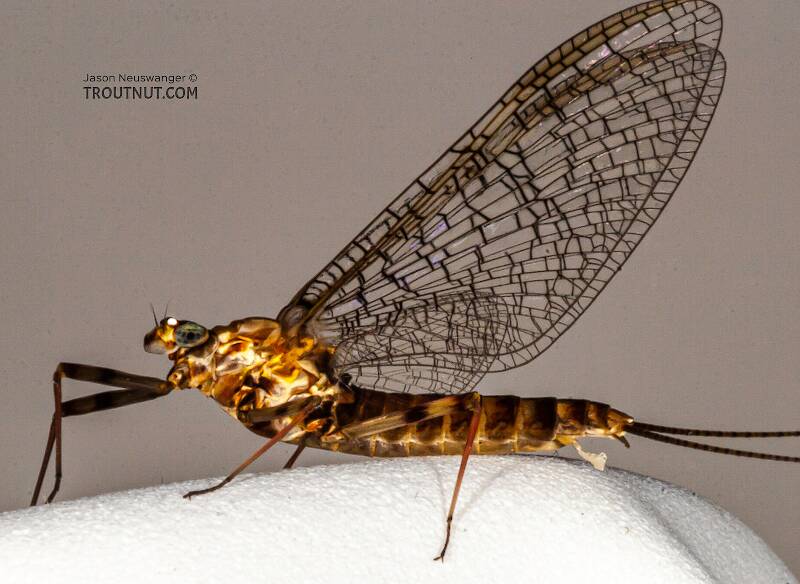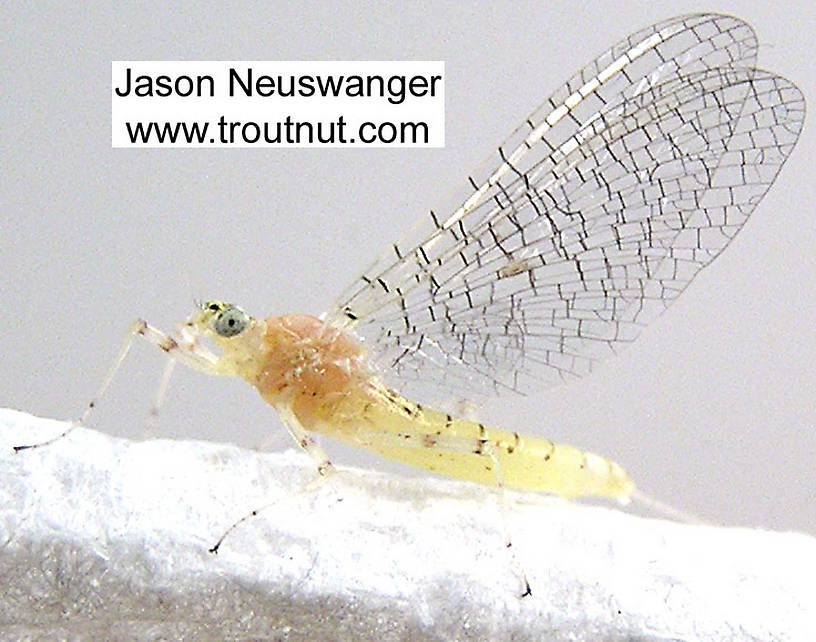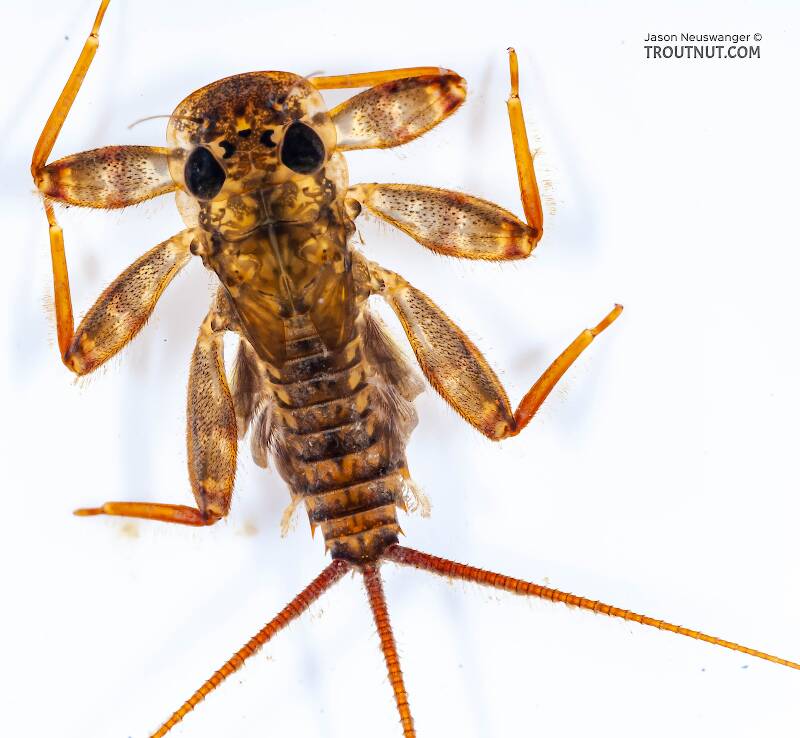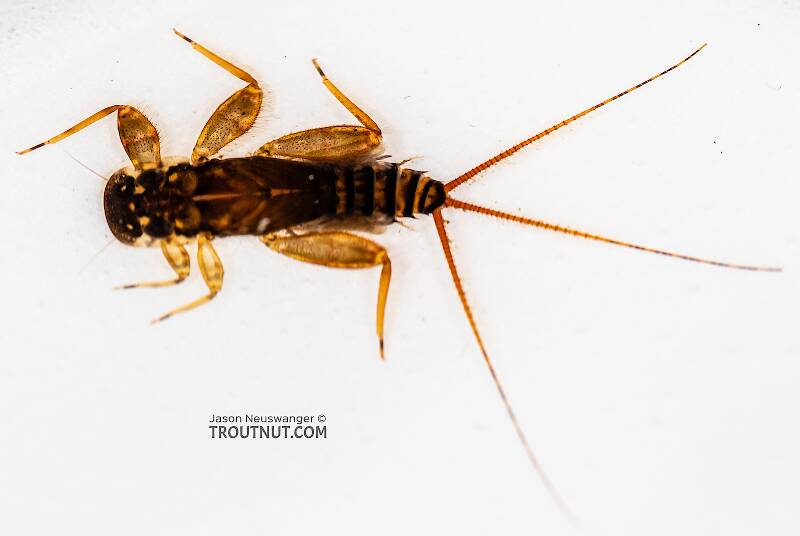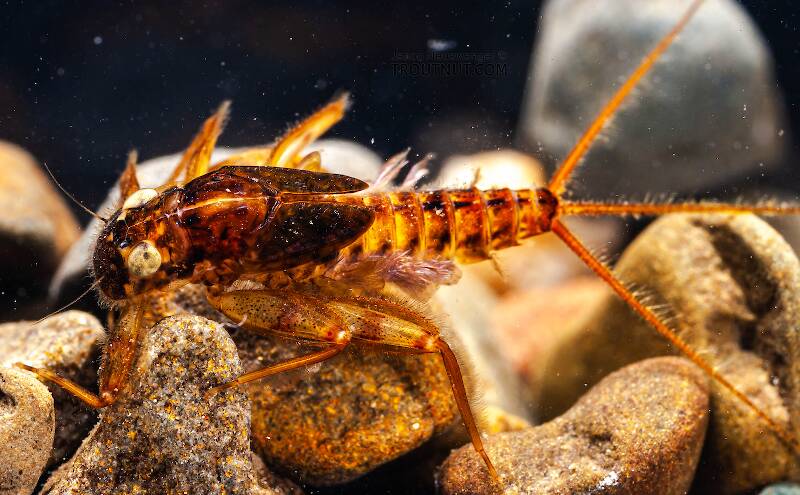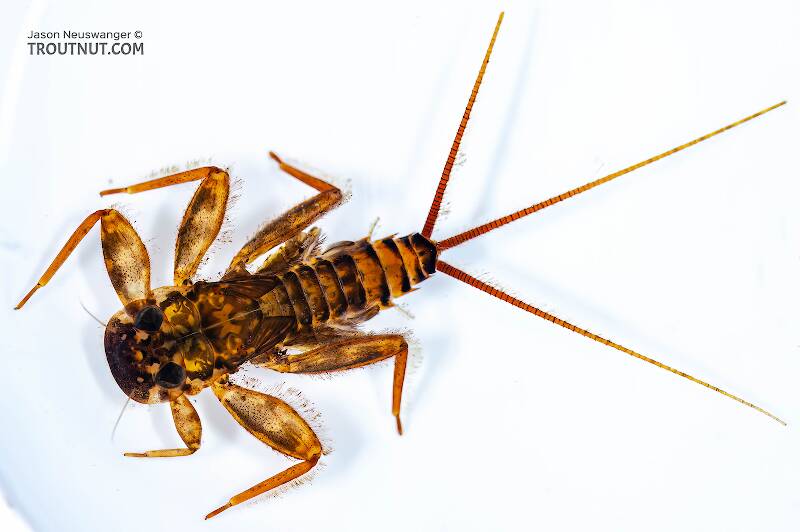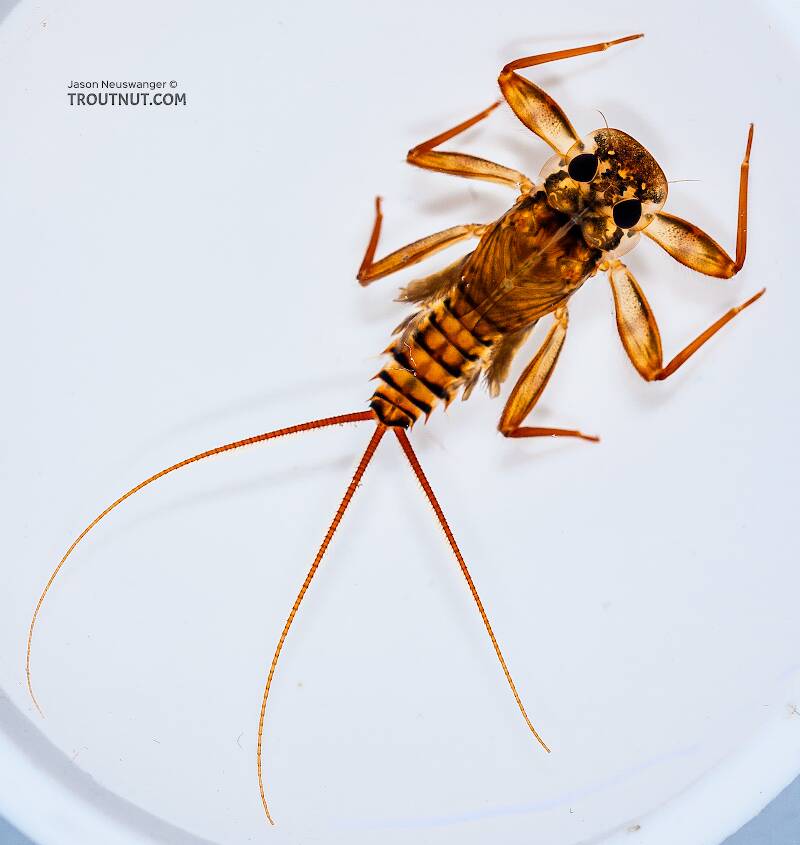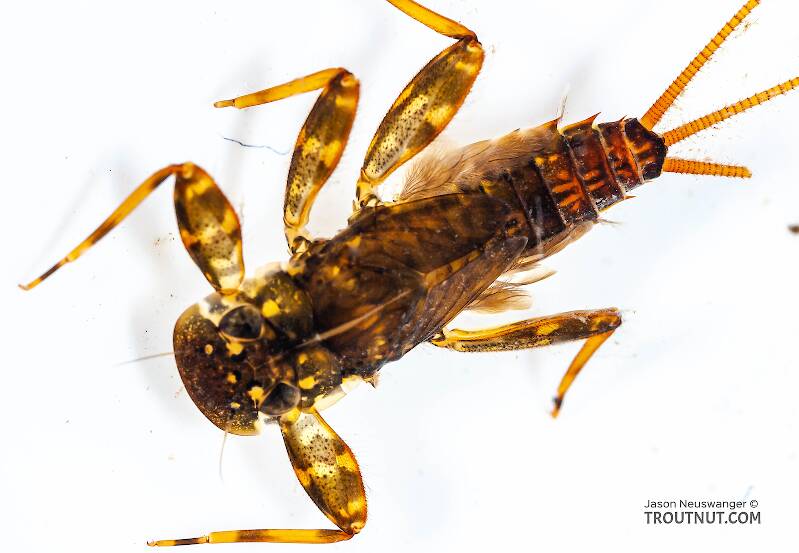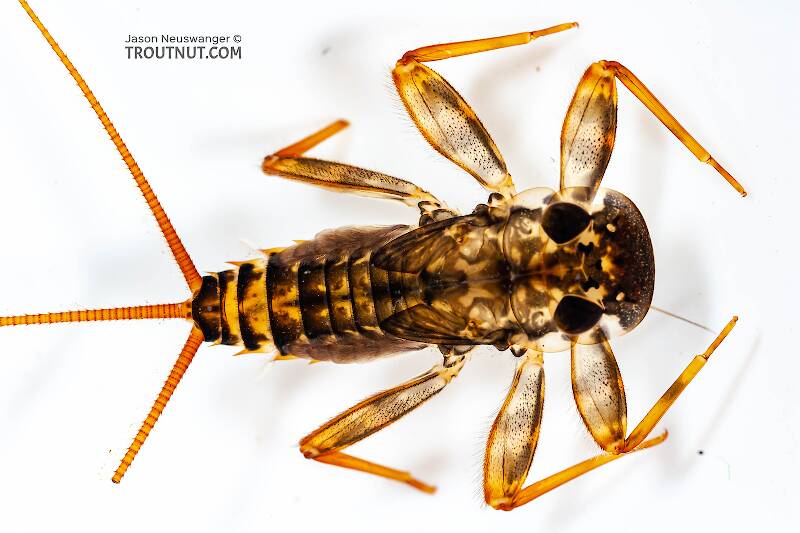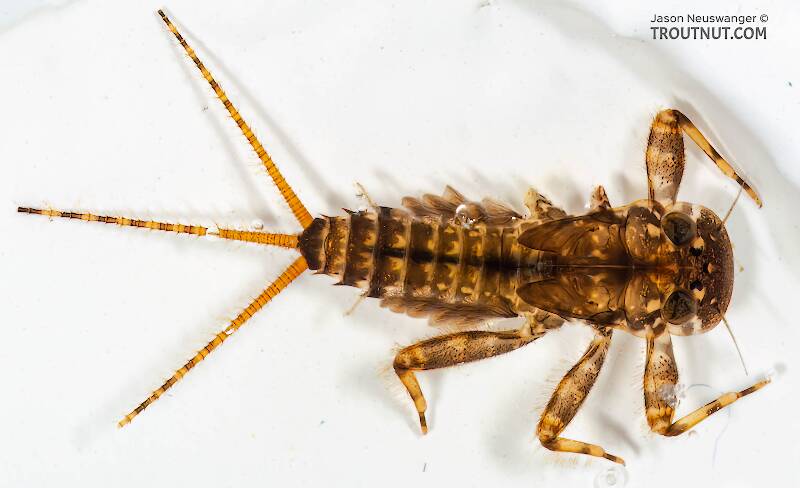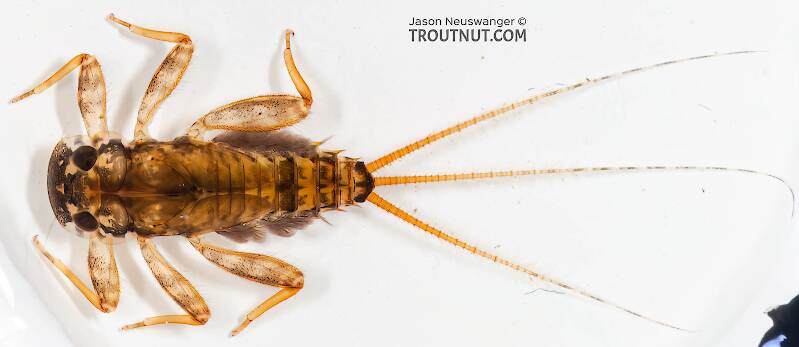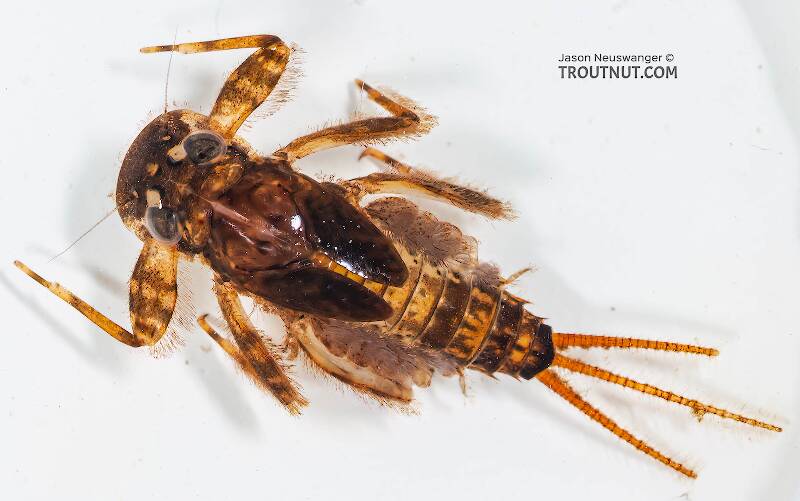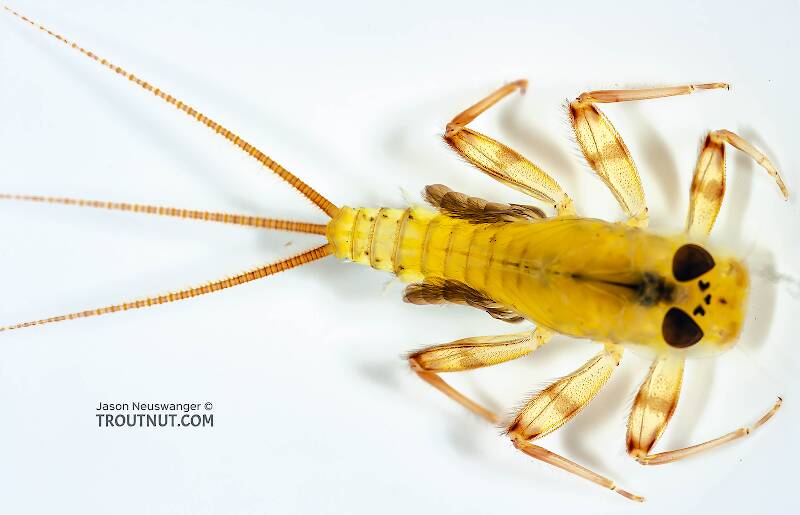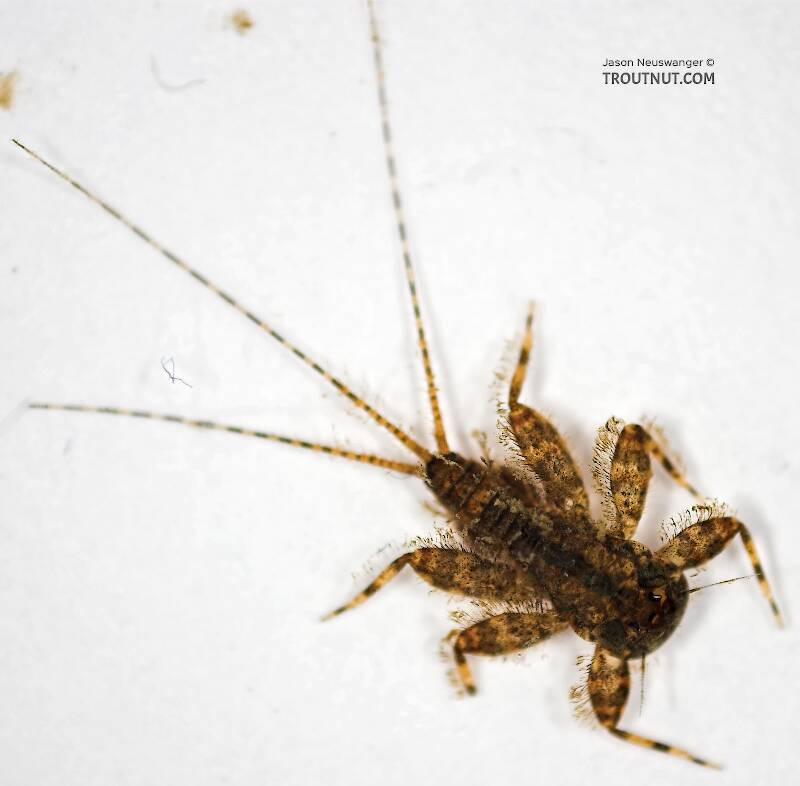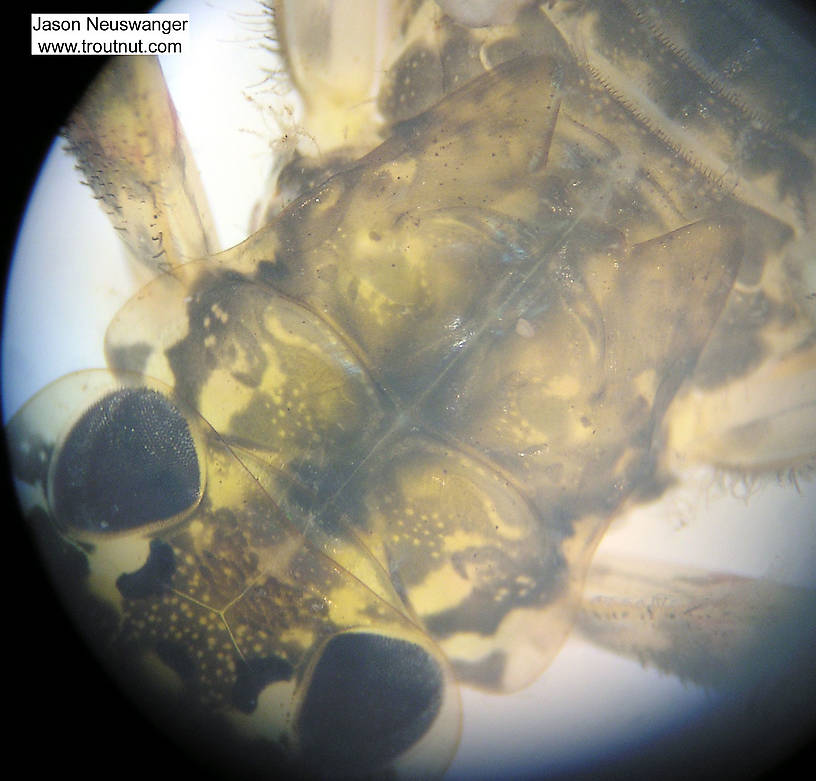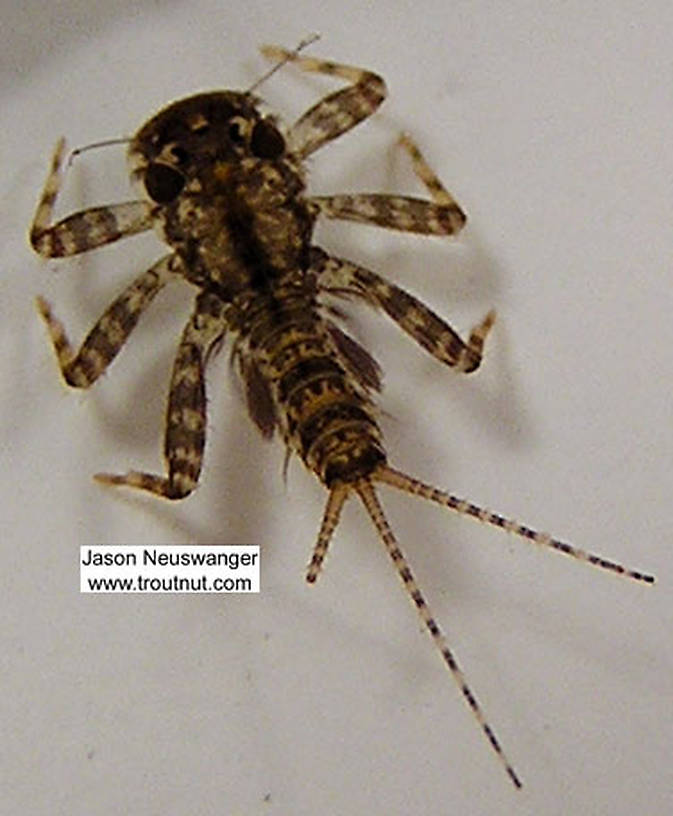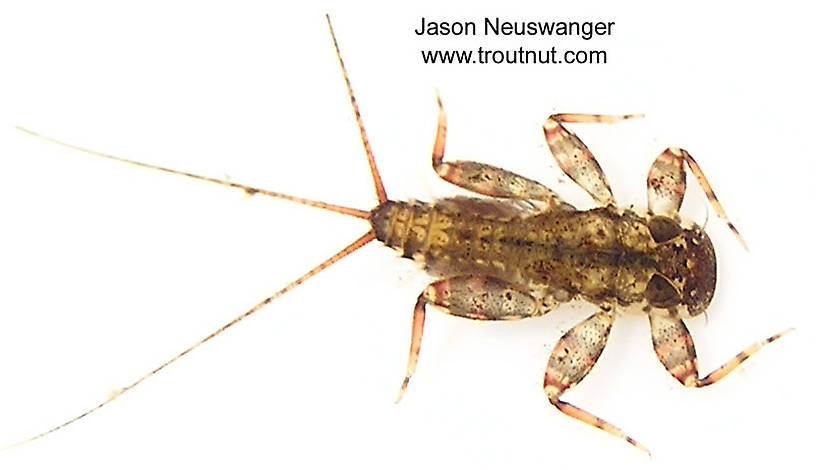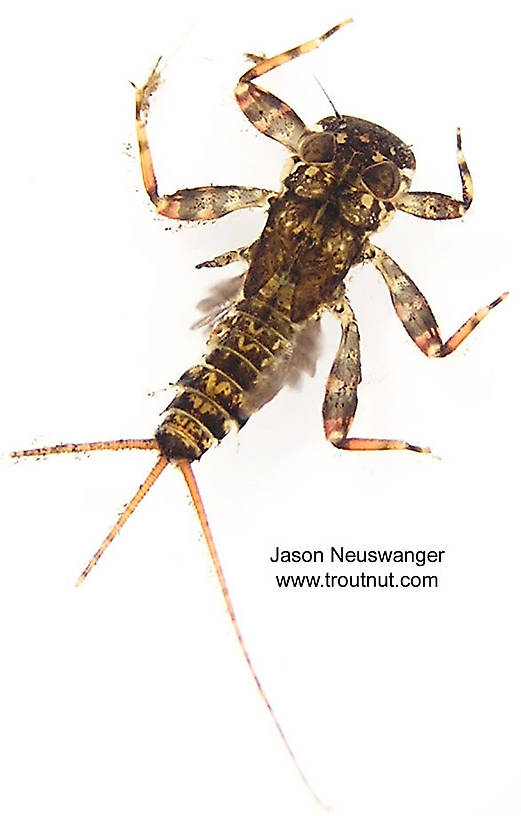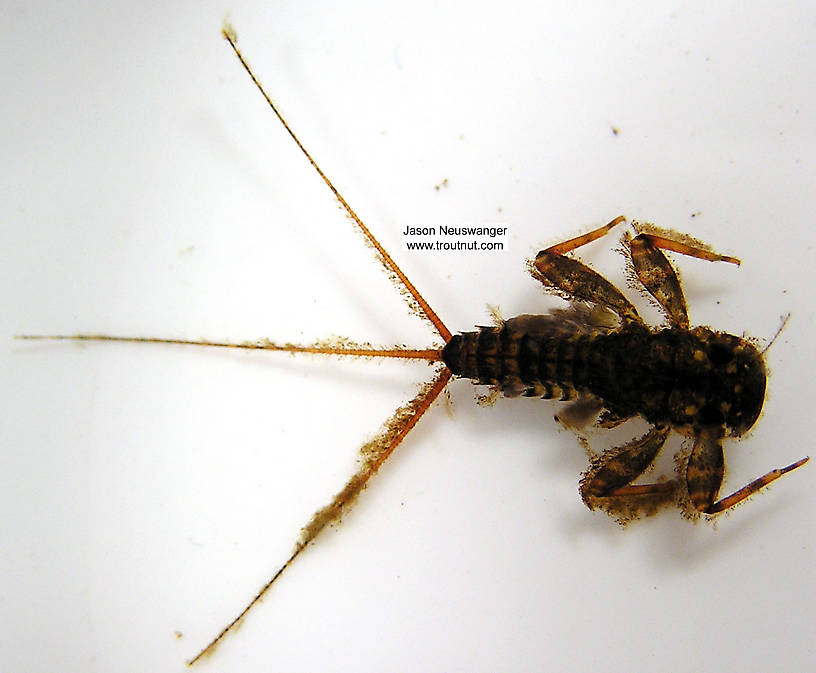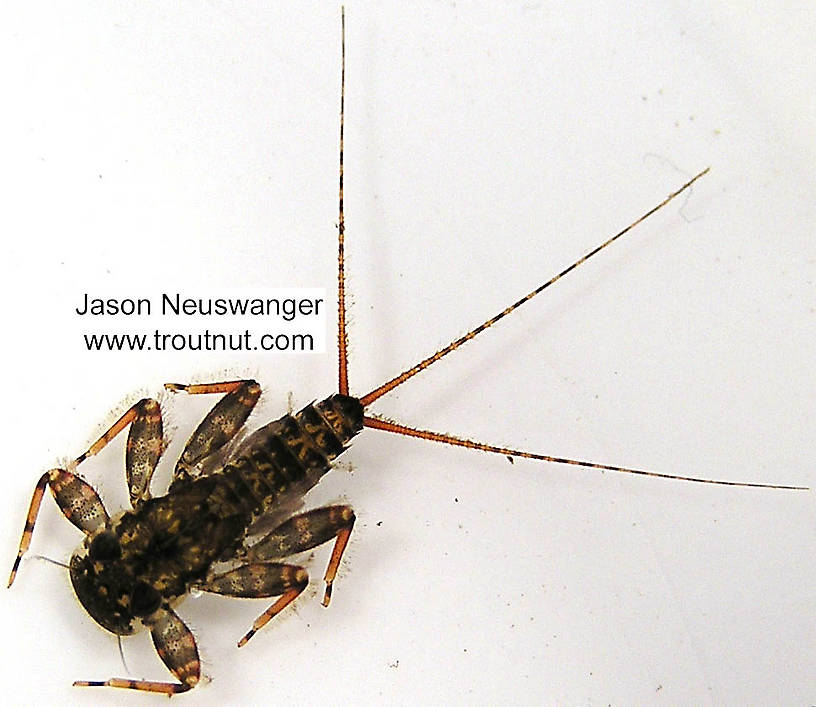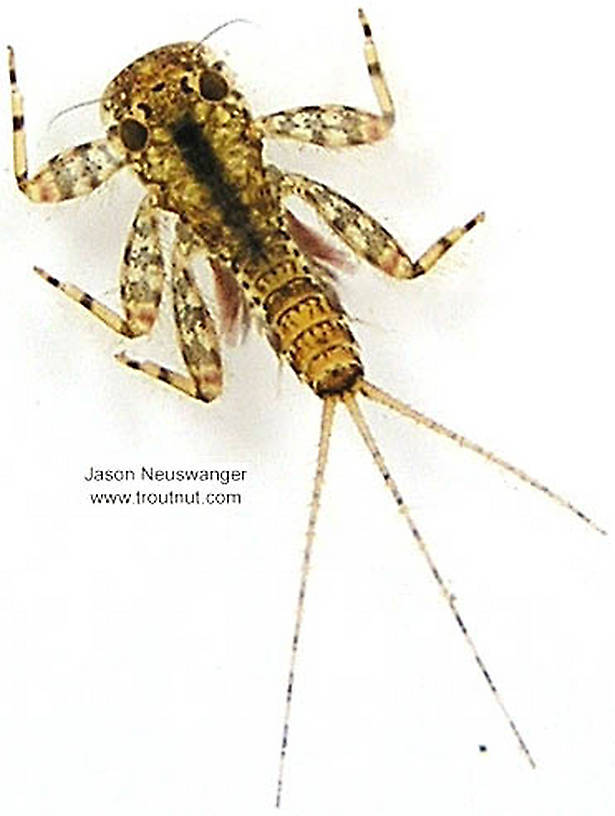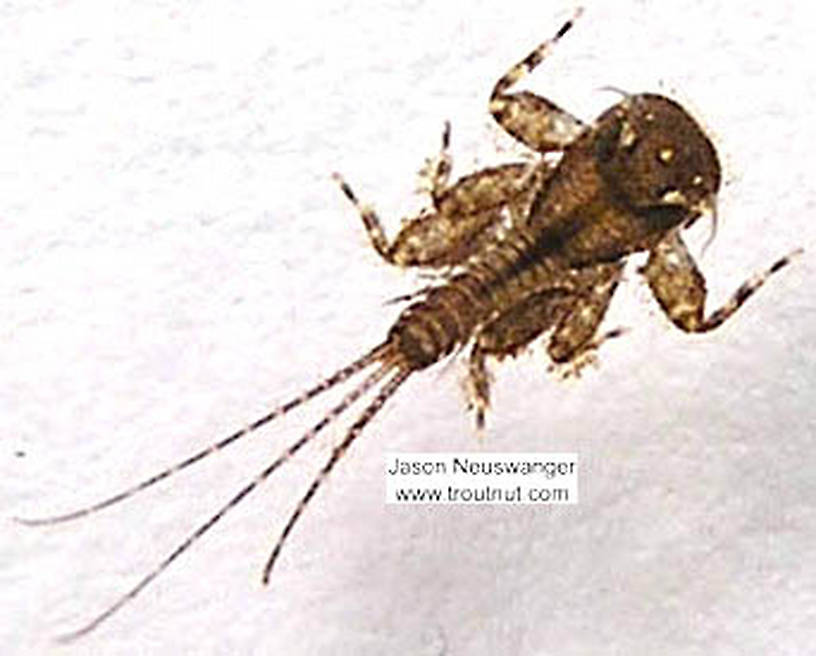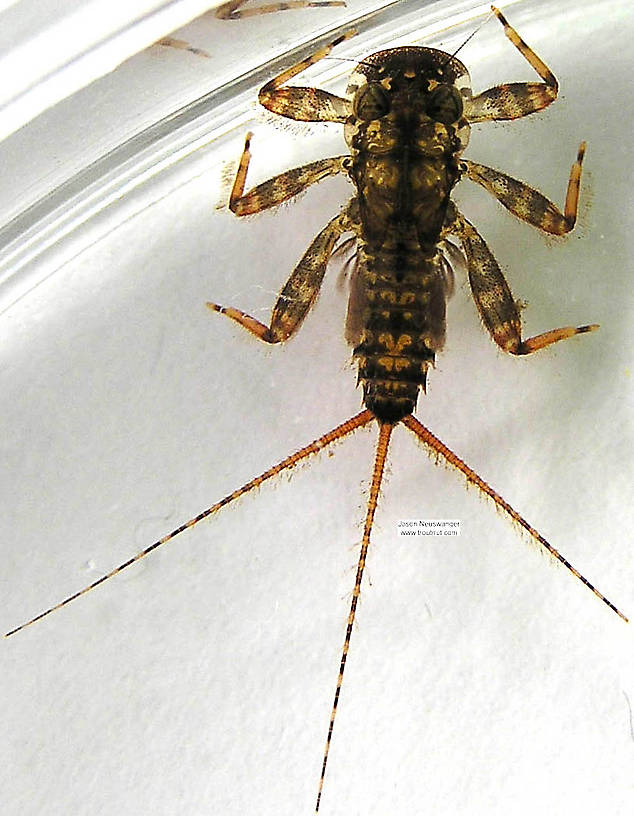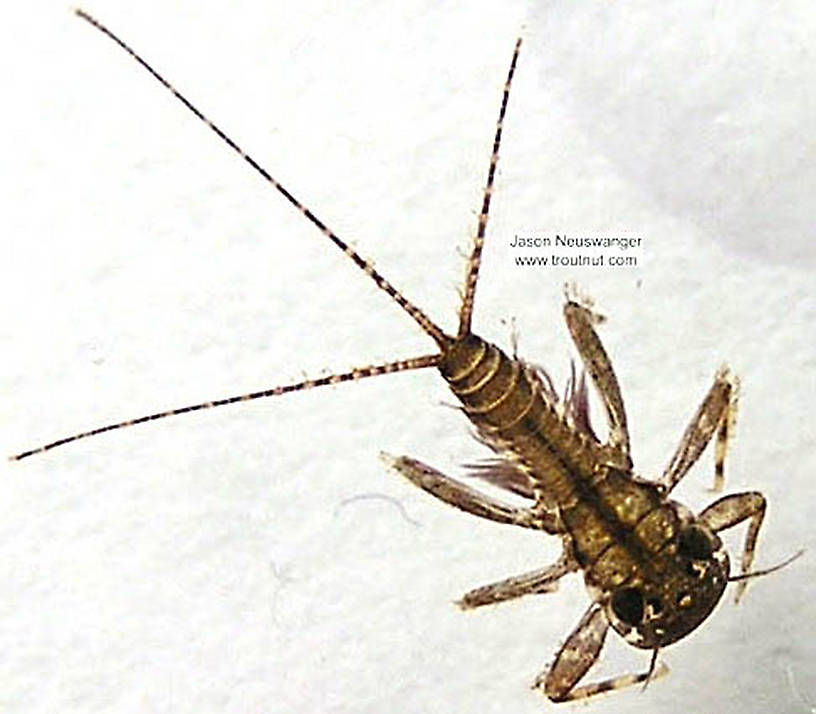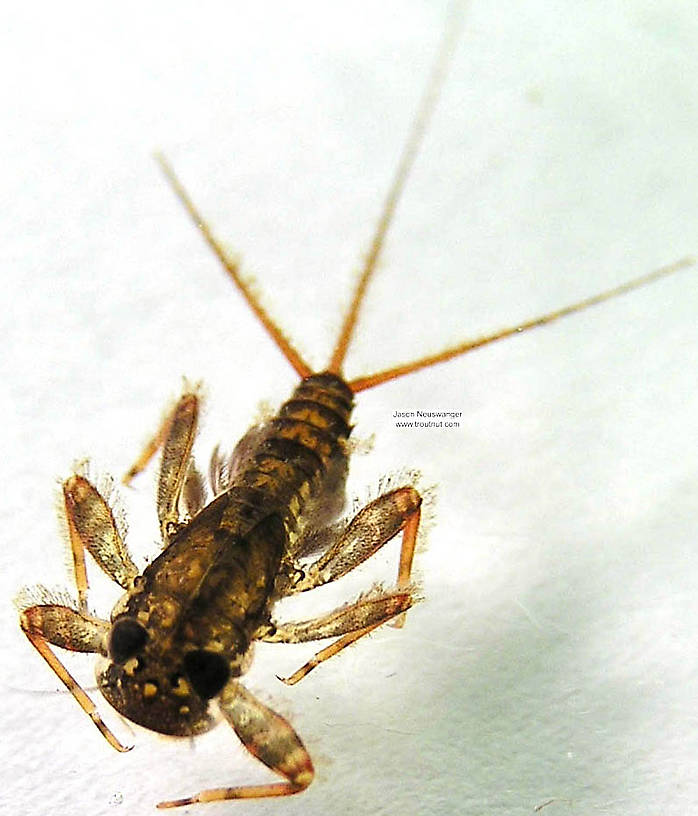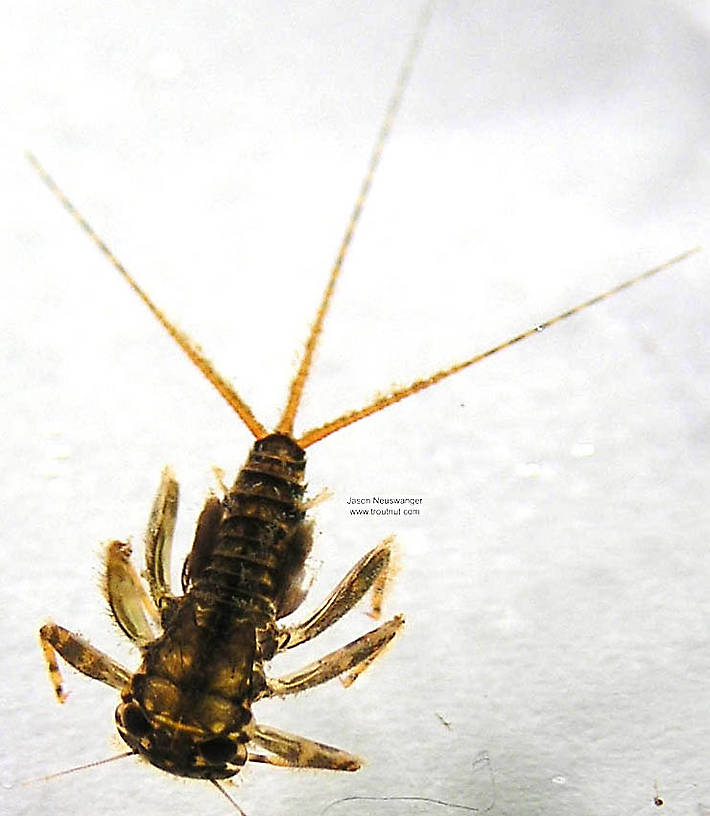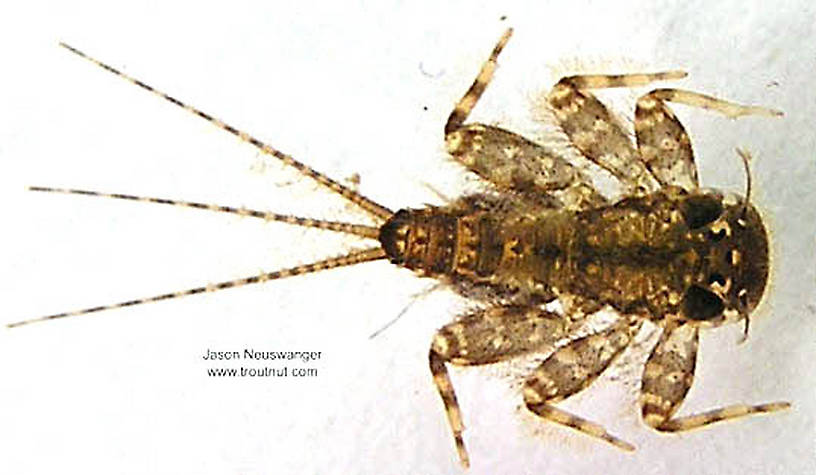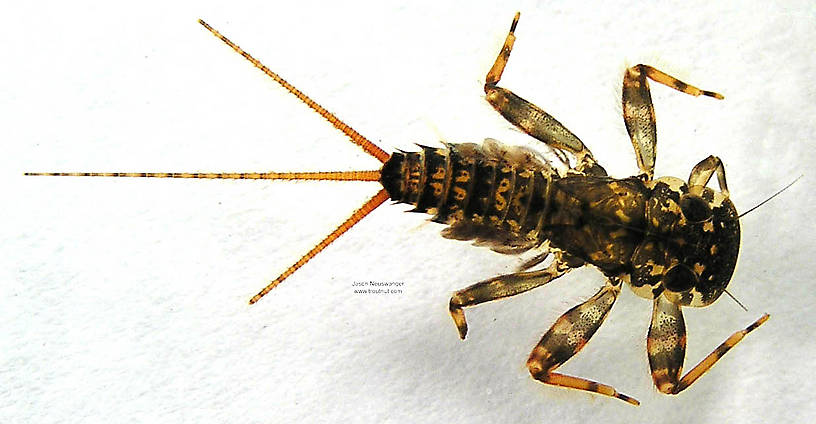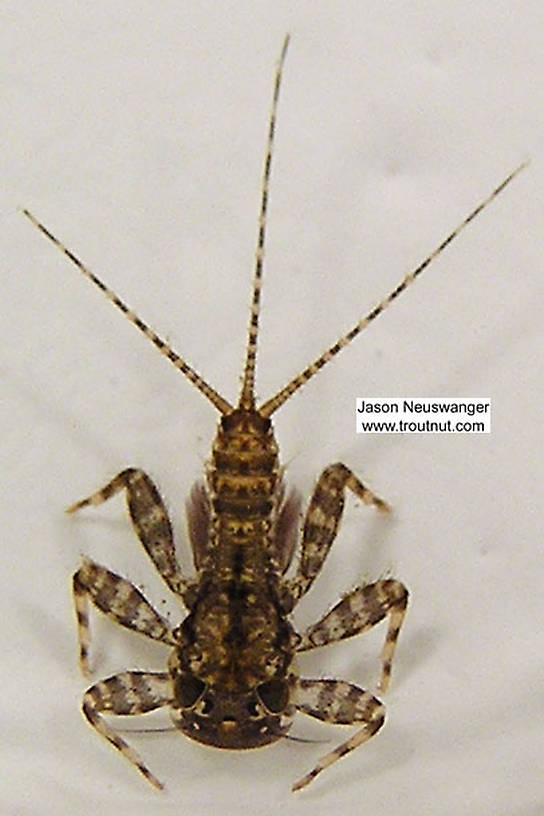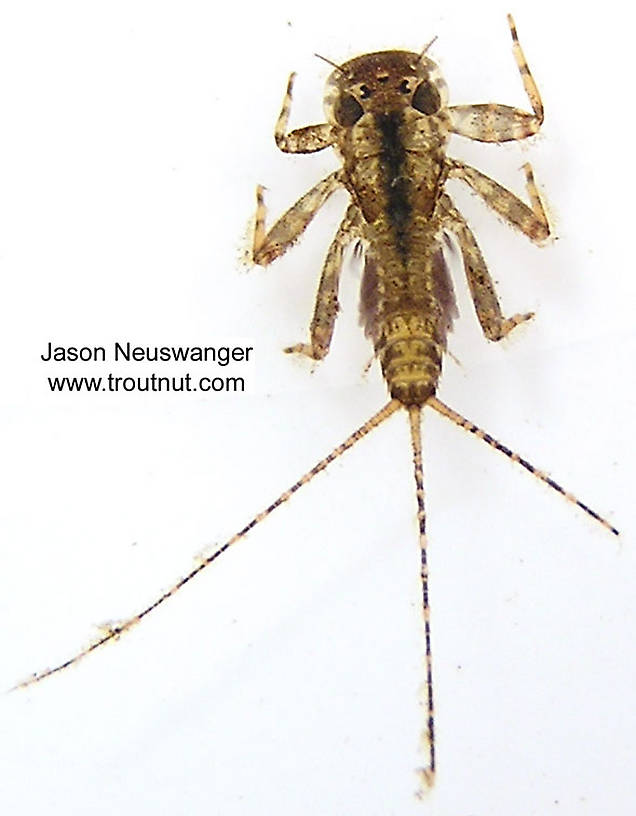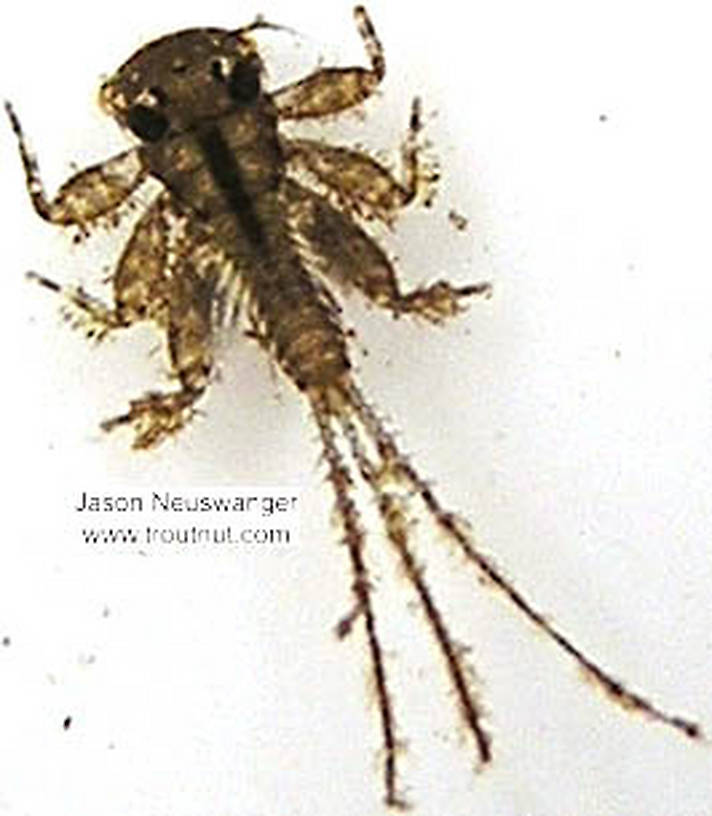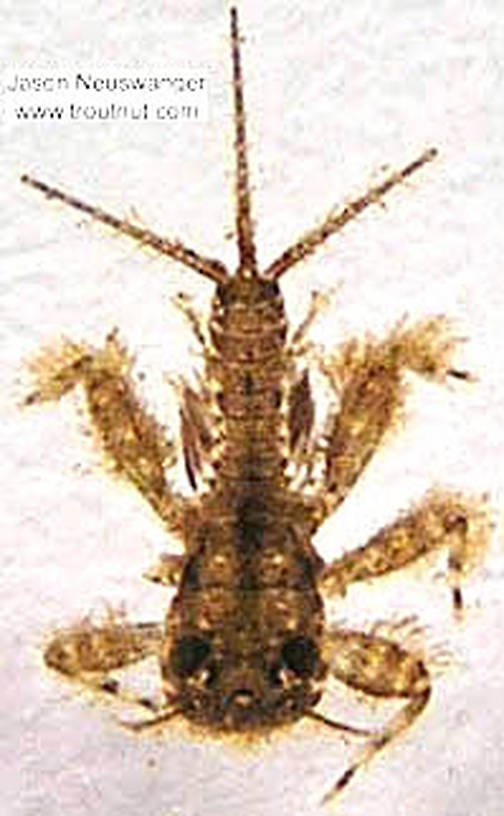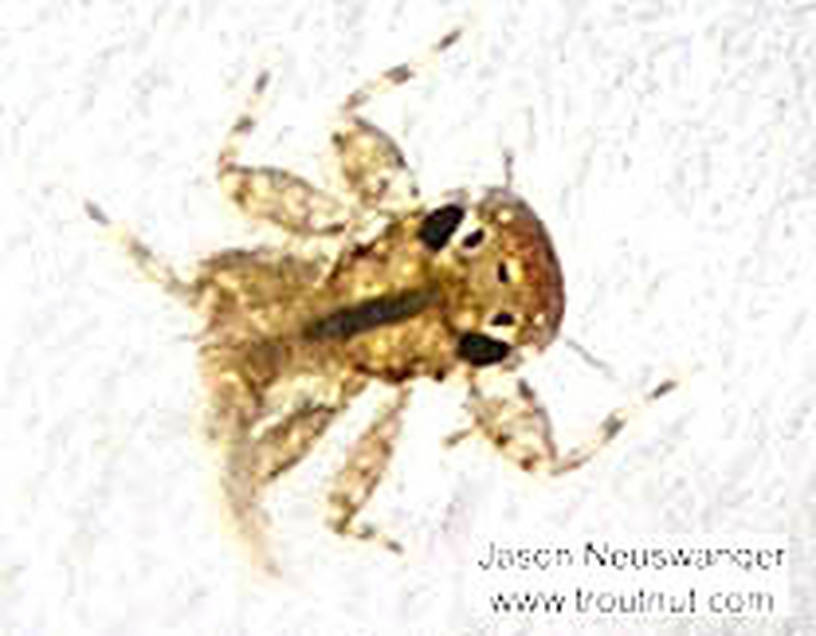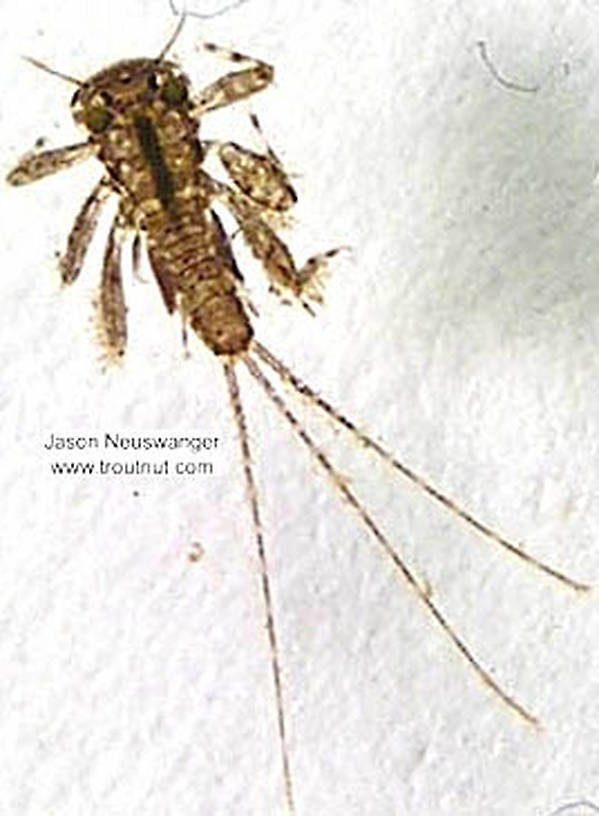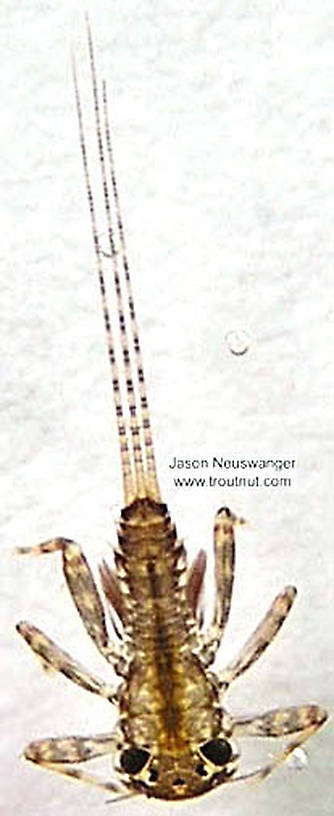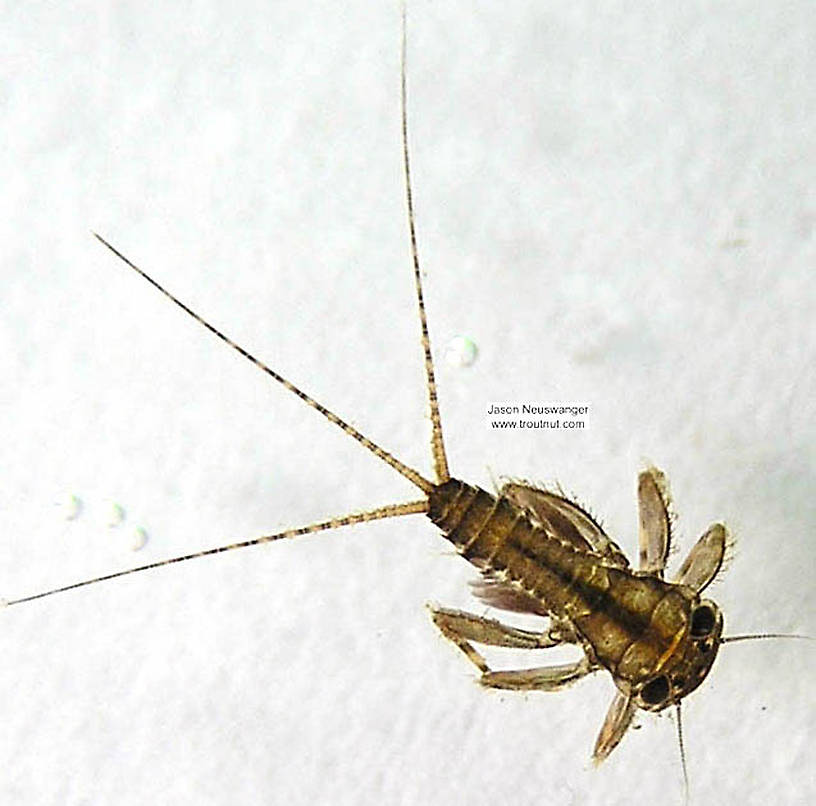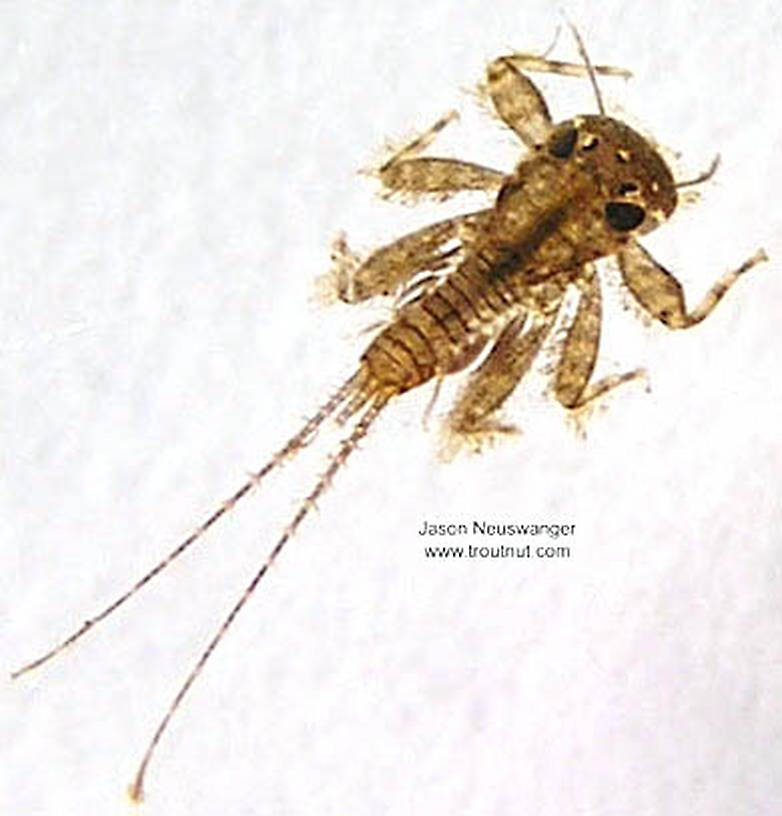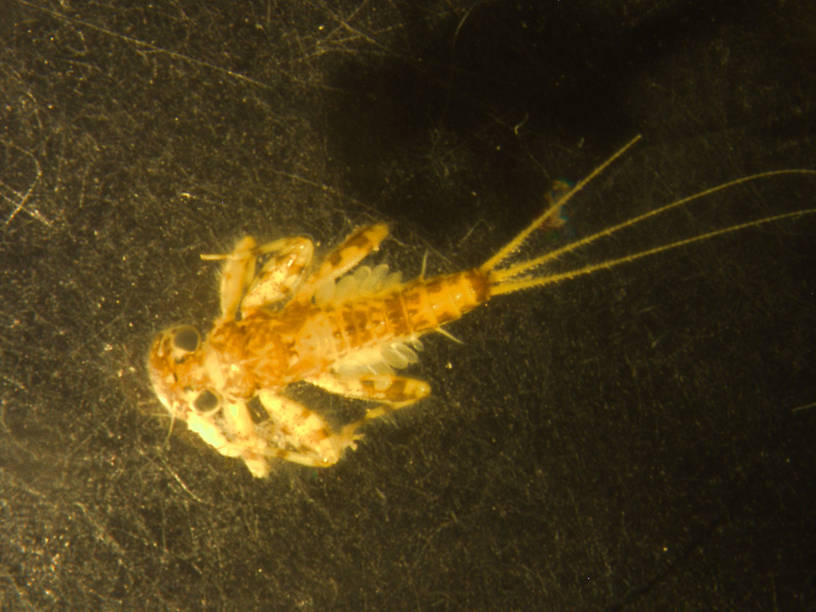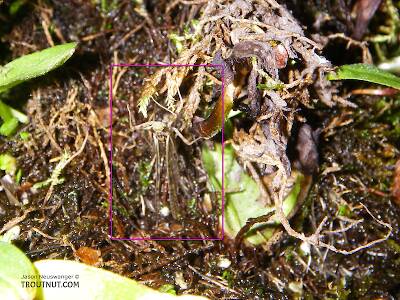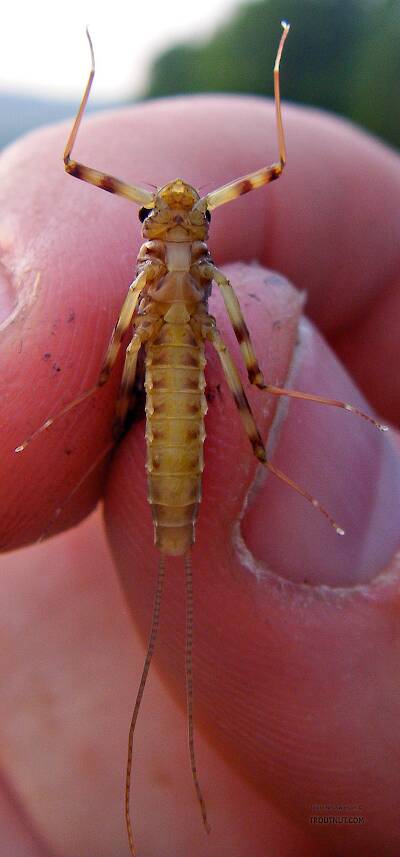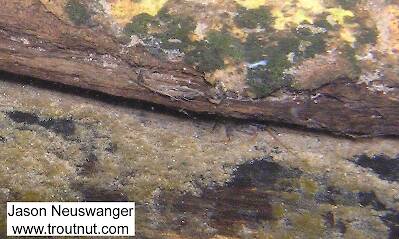
Hex Mayflies
Hexagenia limbata
The famous nocturnal Hex hatch of the Midwest (and a few other lucky locations) stirs to the surface mythically large brown trout that only touch streamers for the rest of the year.
Featured on the forum
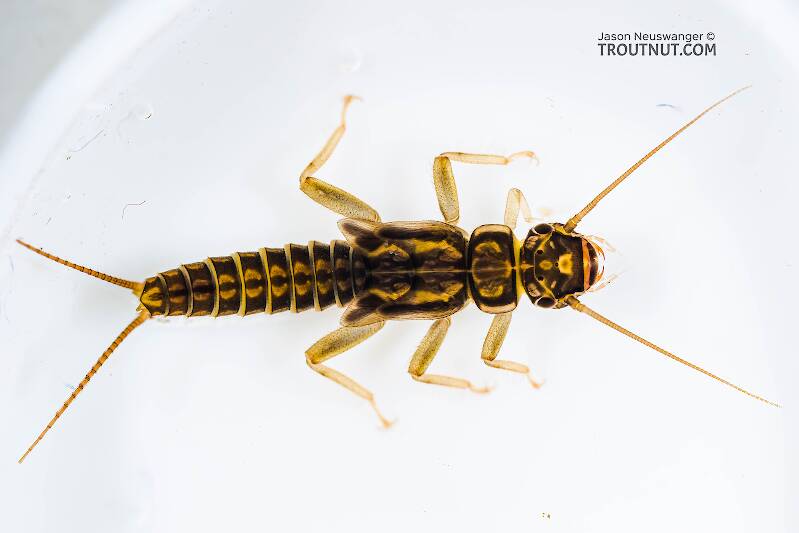

Troutnut is a project started in 2003 by salmonid ecologist Jason "Troutnut" Neuswanger to help anglers and
fly tyers unabashedly embrace the entomological side of the sport. Learn more about Troutnut or
support the project for an enhanced experience here.
Mayfly Genus Stenonema (March Browns and Cahills)
Many of America's traditional flies, like the March Brown and the Light and Dark Cahills, originated in the Catskills to imitate the mayflies of this genus. Caucci and Nastasi wrote of them in Hatches II:
By far the most important species is Stenonema vicarium, variants of which are known to anglers as the March Brown and Gray Fox. Of the others in the "Cahill" group, Stenonema ithaca is the next most important, along with Stenonema modestum and Stenonema pulchellum, which also produce localized fishable hatches. These lesser species together with a few species of Stenacron and the Stenonema femoratum represent the sporadic Light Cahill hatches on evenings in late Spring that often continue throughout the Summer.
"There is a matrimony between Stenonema flies and Catskill rivers that is as synonymous as ham and eggs."
By far the most important species is Stenonema vicarium, variants of which are known to anglers as the March Brown and Gray Fox. Of the others in the "Cahill" group, Stenonema ithaca is the next most important, along with Stenonema modestum and Stenonema pulchellum, which also produce localized fishable hatches. These lesser species together with a few species of Stenacron and the Stenonema femoratum represent the sporadic Light Cahill hatches on evenings in late Spring that often continue throughout the Summer.
Taxonomic History
For over a decade this page lamented the reclassification of iconic Stenonema species into the less storied and euphonious name Maccaffertium. During this time only Stenonema femoratum, a species of minor importance to anglers, remained in the famous genus. However, every once in a while, taxonomists throw anglers a bone. Zembrzuski & Anderson (2018) published results of a genetic analysis showing that there was not a clear basis for the way former Stenonema species were divided into genera, and in fact it makes more sense for now to group them all together in Stenonema.
One species of light cahill known in the old angling literature as Stenonema canadense is now Stenacron interpunctatum, and that has not changed with the new analysis. Another one, Stenonema fuscom, known to some anglers as the Gray Fox, has for many years been recognized as a lighter and slightly smaller variant of the March Brown Stenonema vicarium.
One species of light cahill known in the old angling literature as Stenonema canadense is now Stenacron interpunctatum, and that has not changed with the new analysis. Another one, Stenonema fuscom, known to some anglers as the Gray Fox, has for many years been recognized as a lighter and slightly smaller variant of the March Brown Stenonema vicarium.
Where & when
This genus is only important in the East and Midwest, where they are often the most noticeable members of the Heptageniidae family due to their medium-large size and abundance. In the spring there are superhatches of Stenonema vicarium. The lesser species are primary players on the barren stage of summer evening mayfly hatches. Most of them emerge sporadically for months. Anglers know them as Light Cahills and Cream Cahills, and they often reinforce hatches of the closely related Light Cahill species Stenacron interpunctatum.In 247 records from GBIF, adults of this genus have mostly been collected during June (32%), July (25%), May (15%), August (13%), and April (9%).
In 85 records from GBIF, this genus has been collected at elevations ranging from 282 to 9318 ft, with an average (median) of 2904 ft.
Genus Range
Hatching behavior
The early-season species of Stenonema crawl to slow, shallow water before emerging. Apparently they lose their grip or otherwise end up in the drift during this movement, because they are common in the trout's diet in the weeks before they emerge. Common attractor nymphs like the Hare's Ear are good likenesses of this genus.Most of them are good dry fly insects because they take a long time to emerge and ride the water for a while before getting airborne. They are generally sporadic emergers, but their high populations put at least a few of these insects on the water most nights of the spring and summer.
Nymph biology
Stenonema mayfly nymphs are very adept clingers, but most species are at home in all stream habitats. They (and their close relatives in Stenacron) do not have the high oxygen requirements of the other genera in Heptageniidae.Specimens of the Mayfly Genus Stenonema
6 Male Duns
7 Female Duns
9 Male Spinners
7 Female Spinners
37 Nymphs
2 Streamside Pictures of Stenonema Mayflies:
1 Underwater Picture of Stenonema Mayflies:
Discussions of Stenonema
M. ithaca in M. mediopunctatum section?
3 replies
Posted by GONZO on Sep 1, 2012 in the species Stenonema mediopunctatum
Last reply on Sep 4, 2012 by Entoman
Hi Jason,
In this section, the Midwestern nymphs (#573 & #574) with the dark irregular ventral bars across the anterior portion of the sternites look like Maccaffertium mediopunctatum arwini (the Midwestern ssp.), but the two Eastern duns (#733 & #765) and the associated shuck (of #765) and nymph (#764) look more like Maccaffertium ithaca to me.
Three Maccaffertium species can have very similar ventral markings in the nymph—dark, sinuate, chevron-shaped bars on many of the sternites and dark lateral marks (sometimes connected to form an inverted U-shaped mark) on segment 9. The Eastern mediopunctatum subspecies, M. m. mediopunctatum, has these markings, as does M. ithaca. Similar markings also appear as a less-common variant marking of M. modestum (or the M. modestum species complex). However, these species differ in the length and location of posterolateral projections, leg markings, the appearance of the subs and adults, and size.
Although interpretation of posterolateral projections can be tricky, those projections should help to separate the nymph (and husk) from mediopunctatum. On mediopunctatum, projections are usually on segments 3-9, 4-9, or 5-9, and those on 8 and 9 are fairly long. On ithaca, projections are usually on segments 6-9 or 7-9, and those on 8 and 9 are somewhat shorter (when compared to mediopunctatum). The twin brown bands on the femora of the nymphs should also help to separate them from modestum and mediopunctatum (usually three or four in those species).
The brown posterior margins and median dorsal stripes of the duns (similar to those found in M. vicarium) are typical of ithaca. In McDunnough’s original description of mediopunctatum (1926), he mentions that some of his (paratype) specimens were reared from subimagos, and he describes those subimagos as “quite pale whitish in coloration.”
Size might also be somewhat helpful in distinguishing these specimens from M. m. mediopunctatum (about 7-10 mm at maturity) and modestum (about 8-11 mm at maturity). M. ithaca is about 9-14 mm at maturity. The relatively mature nymph (#764) is at least 11 mm, the female dun (#733) is about 13 mm, and the male dun (#765) is about 11 mm.
When all of these factors are considered, it seems to me that M. ithaca is a more likely ID for the Eastern specimens. (See Bednarik and McCafferty 1979 and Lewis 1974.) I would suggest the following placement for specimens currently in this section:
M. ithaca nymph: http://www.troutnut.com/specimen/764
M. ithaca female dun: http://www.troutnut.com/specimen/733
M. ithaca male dun: http://www.troutnut.com/specimen/765
M. mediopunctatum arwini nymph: http://www.troutnut.com/specimen/573
M. mediopunctatum arwini nymph: http://www.troutnut.com/specimen/574
Best,
Lloyd
In this section, the Midwestern nymphs (#573 & #574) with the dark irregular ventral bars across the anterior portion of the sternites look like Maccaffertium mediopunctatum arwini (the Midwestern ssp.), but the two Eastern duns (#733 & #765) and the associated shuck (of #765) and nymph (#764) look more like Maccaffertium ithaca to me.
Three Maccaffertium species can have very similar ventral markings in the nymph—dark, sinuate, chevron-shaped bars on many of the sternites and dark lateral marks (sometimes connected to form an inverted U-shaped mark) on segment 9. The Eastern mediopunctatum subspecies, M. m. mediopunctatum, has these markings, as does M. ithaca. Similar markings also appear as a less-common variant marking of M. modestum (or the M. modestum species complex). However, these species differ in the length and location of posterolateral projections, leg markings, the appearance of the subs and adults, and size.
Although interpretation of posterolateral projections can be tricky, those projections should help to separate the nymph (and husk) from mediopunctatum. On mediopunctatum, projections are usually on segments 3-9, 4-9, or 5-9, and those on 8 and 9 are fairly long. On ithaca, projections are usually on segments 6-9 or 7-9, and those on 8 and 9 are somewhat shorter (when compared to mediopunctatum). The twin brown bands on the femora of the nymphs should also help to separate them from modestum and mediopunctatum (usually three or four in those species).
The brown posterior margins and median dorsal stripes of the duns (similar to those found in M. vicarium) are typical of ithaca. In McDunnough’s original description of mediopunctatum (1926), he mentions that some of his (paratype) specimens were reared from subimagos, and he describes those subimagos as “quite pale whitish in coloration.”
Size might also be somewhat helpful in distinguishing these specimens from M. m. mediopunctatum (about 7-10 mm at maturity) and modestum (about 8-11 mm at maturity). M. ithaca is about 9-14 mm at maturity. The relatively mature nymph (#764) is at least 11 mm, the female dun (#733) is about 13 mm, and the male dun (#765) is about 11 mm.
When all of these factors are considered, it seems to me that M. ithaca is a more likely ID for the Eastern specimens. (See Bednarik and McCafferty 1979 and Lewis 1974.) I would suggest the following placement for specimens currently in this section:
M. ithaca nymph: http://www.troutnut.com/specimen/764
M. ithaca female dun: http://www.troutnut.com/specimen/733
M. ithaca male dun: http://www.troutnut.com/specimen/765
M. mediopunctatum arwini nymph: http://www.troutnut.com/specimen/573
M. mediopunctatum arwini nymph: http://www.troutnut.com/specimen/574
Best,
Lloyd
Stenonema femoratum male spinner
3 replies
Posted by Jmw975 on May 21, 2012
Last reply on May 21, 2012 by Entoman
2 tails or 3
1 replies
Posted by Snagy on Feb 5, 2010 in the species Stenonema vicarium
Last reply on Feb 6, 2010 by Taxon
I notice that while the dun, nymph, and spinner photos on the page are all listed as March Brown (maccaffertium vicarium). While the coloration patterns all seem to follow other March Browns I have seen, I notice that the winged flies pictures all have 2 tails, but the nymphs in the photos have 3. I was under the impression this species was a 2 tailed mayfly. Is the nymph mislabelled?
Anybody know more about Maccaffertium terminatum?
3 replies
Posted by Troutnut on Jun 8, 2007 in the species Stenonema terminatum
Last reply on Jun 11, 2007 by Konchu
I just wrote up what I found on the page for this species. I was mildly surprised to see so many of a species I've never seen mentioned in an angling context -- at least a few dozen throughout the evening. They piqued my curiosity.
diff between march brown &gray fox
7 replies
Posted by Jrcald on Mar 12, 2007 in the species Stenonema vicarium
Last reply on Mar 13, 2007 by Troutnut
i know that gray foxs and march browns are classified in the same family but what are the differences ? what is the color differences are both bodies the same color tan ?
Start a Discussion of Stenonema
References
- Caucci, Al and Nastasi, Bob. 2004. Hatches II. The Lyons Press.
Mayfly Genus Stenonema (March Browns and Cahills)
Taxonomy
Species in Stenonema
Stenonema exiguum
0
0
Stenonema femoratumCream Cahills
1
6
Stenonema ithacaLight Cahills
4
34
Stenonema luteum
1
4
Stenonema mediopunctatumCream Cahills
2
6
Stenonema mexicanumCream Cahills
0
0
Stenonema modestumCream Cahills
10
51
Stenonema pudicum
1
6
Stenonema pulchellumLight Cahills
0
0
Stenonema terminatum
5
28
Stenonema vicariumMarch Browns
20
93
Species in Stenonema: Stenonema exiguum, Stenonema femoratum, Stenonema ithaca, Stenonema luteum, Stenonema mediopunctatum, Stenonema mexicanum, Stenonema modestum, Stenonema pudicum, Stenonema pulchellum, Stenonema terminatum, Stenonema vicarium
7 species (Stenonema bednariki, Stenonema carlsoni, Stenonema flaveolum, Stenonema lenati, Stenonema meririvulanum, Stenonema sinclairi, and Stenonema smithae) aren't included.


